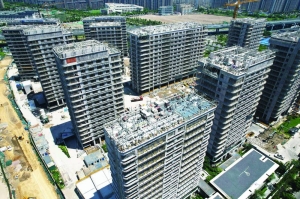East Asia
China’s economy falters, raises pressure for more stimulus


A general view of an under-construction residential housing complex in Hangzhou in China’s eastern Zhejiang province. China posted lower than expected growth in the second quarter yesterday.
China’s economy grew much slower than expected in the second quarter, as a protracted property downturn and job insecurity knocked the wind out of a fragile recovery, keeping alive expectations Beijing will need to unleash even more stimulus.The world’s second-largest economy grew 4.7% in April-June, official data showed, its slowest since the first quarter of 2023 and missing a 5.1% analyst forecast in a Reuters poll. It also slowed from the previous quarter’s 5.3% expansion.
Of particular concern was the consumer sector, with retail sales growth grinding to an 18-month low as deflationary pressures forced businesses to slash prices on everything from cars to food to clothes.
“Overall, the disappointing GDP data shows that the road to hitting the 5% growth target remains challenging,” said Lynn Song, chief economist for Greater China at ING.
“A negative wealth effect from falling property and stock prices, as well as low wage growth amid various industries’ cost cutting is dragging consumption and causing a pivot from big ticket purchases toward basic ‘eat, drink and play’ theme consumption,” he added.
The years-long property crisis deepened in June as new home prices fell at the fastest pace in nine years, battering consumer confidence and constraining debt-laden local governments’ ability to generate fresh funds through land sales.
Analysts expect cutting debt and boosting confidence to be the main focus of a key economic leadership meeting in Beijing this week, although solving one of those problems may make it difficult to fix another. The government is aiming for economic growth of around 5.0% for 2024, a target that many analysts believe is ambitious and may require more stimulus.
The sharper-than-expected growth slowdown in the second quarter prompted Goldman Sachs on Monday to lower its forecast for China’s 2024 growth to 4.9% from 5.0%.
“To counteract weak domestic demand, we believe more policy easing is necessary through the remainder of this year, especially on the fiscal and housing fronts,” said Goldman Sachs economists, led by Lisheng Wang, in a note.
On a quarterly basis, growth came in at 0.7% from a downwardly revised 1.5% in the previous three months, the data from the National Bureau of Statistics (NBS) showed.
To counter soft domestic demand and a property crisis, China has boosted infrastructure investment and ploughed funds into high-tech manufacturing.
China’s yuan and stocks fell following the disappointing data, but share markets later closed higher as investors bet on more stimulus.
The figures come as Beijing seeks to shore up economic confidence at a highly anticipated third plenum, a key leadership meeting that starts on Monday, although conflicting requirements such as boosting growth and cutting debt complicate those plans.
The NBS said while bad weather accounted for some of the hit to growth in the second quarter, the economy faced increasing external uncertainties and domestic difficulties in the second half.
Economic growth in China has been uneven with industrial output outstripping domestic consumption, fanning deflationary risks amid the property downturn and mounting local government debt.
While solid Chinese exports have provided some support, rising trade tensions now pose a threat. Broadly reflecting those trends, separate data on Monday showed factory output growth beating expectations in June but still slowing from May.
That follows data released earlier this month that showed China’s exports in June up 8.6% from a year earlier, and imports unexpectedly shrinking 2.3%, suggesting manufacturers are frontloading orders to get ahead of tariffs from trade partners.
The bigger pain point on Monday, however, was seen in retail sales, which rose 2.0% year-on-year, missing forecasts and the slowest growth since December 2022.
“Among all the monthly figures released today, the highlight is the weak retail sales,” said Xing Zhaopeng, senior China strategist at ANZ.
Of particular concern was the consumer sector, with retail sales growth grinding to an 18-month low as deflationary pressures forced businesses to slash prices on everything from cars to food to clothes.
“Overall, the disappointing GDP data shows that the road to hitting the 5% growth target remains challenging,” said Lynn Song, chief economist for Greater China at ING.
“A negative wealth effect from falling property and stock prices, as well as low wage growth amid various industries’ cost cutting is dragging consumption and causing a pivot from big ticket purchases toward basic ‘eat, drink and play’ theme consumption,” he added.
The years-long property crisis deepened in June as new home prices fell at the fastest pace in nine years, battering consumer confidence and constraining debt-laden local governments’ ability to generate fresh funds through land sales.
Analysts expect cutting debt and boosting confidence to be the main focus of a key economic leadership meeting in Beijing this week, although solving one of those problems may make it difficult to fix another. The government is aiming for economic growth of around 5.0% for 2024, a target that many analysts believe is ambitious and may require more stimulus.
The sharper-than-expected growth slowdown in the second quarter prompted Goldman Sachs on Monday to lower its forecast for China’s 2024 growth to 4.9% from 5.0%.
“To counteract weak domestic demand, we believe more policy easing is necessary through the remainder of this year, especially on the fiscal and housing fronts,” said Goldman Sachs economists, led by Lisheng Wang, in a note.
On a quarterly basis, growth came in at 0.7% from a downwardly revised 1.5% in the previous three months, the data from the National Bureau of Statistics (NBS) showed.
To counter soft domestic demand and a property crisis, China has boosted infrastructure investment and ploughed funds into high-tech manufacturing.
China’s yuan and stocks fell following the disappointing data, but share markets later closed higher as investors bet on more stimulus.
The figures come as Beijing seeks to shore up economic confidence at a highly anticipated third plenum, a key leadership meeting that starts on Monday, although conflicting requirements such as boosting growth and cutting debt complicate those plans.
The NBS said while bad weather accounted for some of the hit to growth in the second quarter, the economy faced increasing external uncertainties and domestic difficulties in the second half.
Economic growth in China has been uneven with industrial output outstripping domestic consumption, fanning deflationary risks amid the property downturn and mounting local government debt.
While solid Chinese exports have provided some support, rising trade tensions now pose a threat. Broadly reflecting those trends, separate data on Monday showed factory output growth beating expectations in June but still slowing from May.
That follows data released earlier this month that showed China’s exports in June up 8.6% from a year earlier, and imports unexpectedly shrinking 2.3%, suggesting manufacturers are frontloading orders to get ahead of tariffs from trade partners.
The bigger pain point on Monday, however, was seen in retail sales, which rose 2.0% year-on-year, missing forecasts and the slowest growth since December 2022.
“Among all the monthly figures released today, the highlight is the weak retail sales,” said Xing Zhaopeng, senior China strategist at ANZ.







